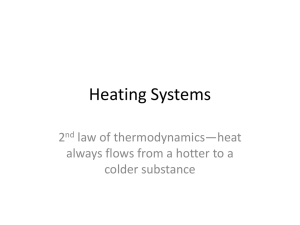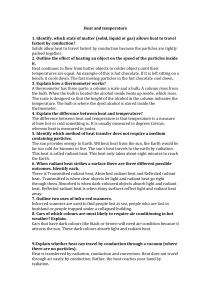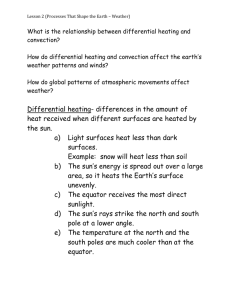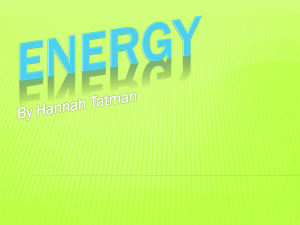Ondol Radiant Heat in Korea
advertisement
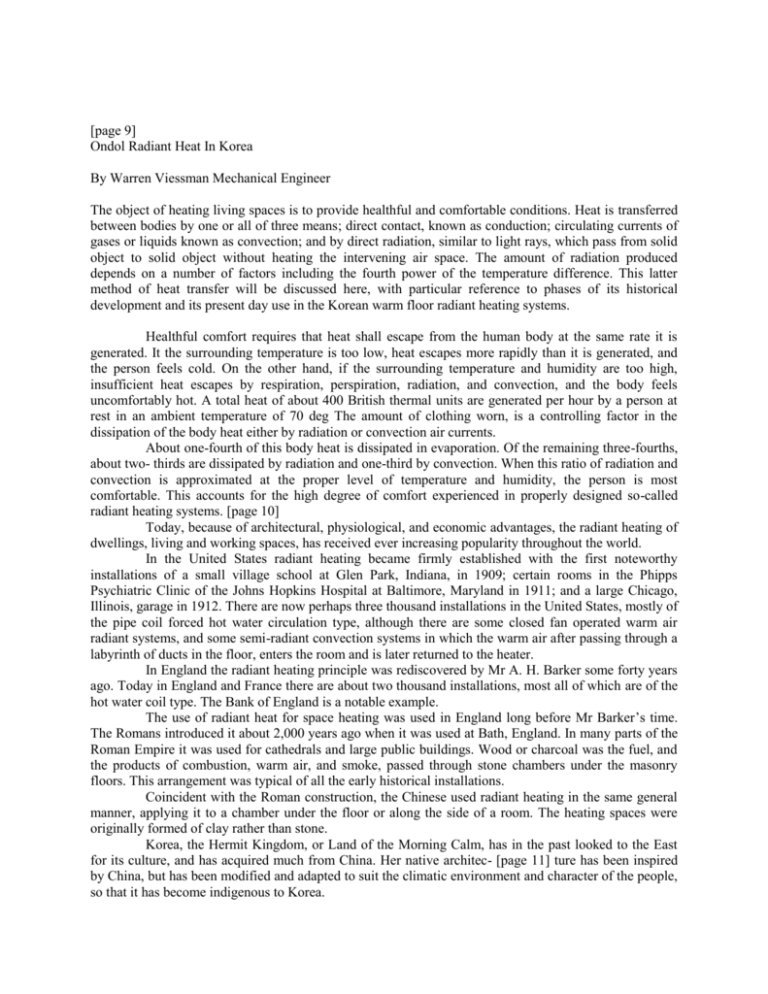
[page 9] Ondol Radiant Heat In Korea By Warren Viessman Mechanical Engineer The object of heating living spaces is to provide healthful and comfortable conditions. Heat is transferred between bodies by one or all of three means; direct contact, known as conduction; circulating currents of gases or liquids known as convection; and by direct radiation, similar to light rays, which pass from solid object to solid object without heating the intervening air space. The amount of radiation produced depends on a number of factors including the fourth power of the temperature difference. This latter method of heat transfer will be discussed here, with particular reference to phases of its historical development and its present day use in the Korean warm floor radiant heating systems. Healthful comfort requires that heat shall escape from the human body at the same rate it is generated. It the surrounding temperature is too low, heat escapes more rapidly than it is generated, and the person feels cold. On the other hand, if the surrounding temperature and humidity are too high, insufficient heat escapes by respiration, perspiration, radiation, and convection, and the body feels uncomfortably hot. A total heat of about 400 British thermal units are generated per hour by a person at rest in an ambient temperature of 70 deg The amount of clothing worn, is a controlling factor in the dissipation of the body heat either by radiation or convection air currents. About one-fourth of this body heat is dissipated in evaporation. Of the remaining three-fourths, about two- thirds are dissipated by radiation and one-third by convection. When this ratio of radiation and convection is approximated at the proper level of temperature and humidity, the person is most comfortable. This accounts for the high degree of comfort experienced in properly designed so-called radiant heating systems. [page 10] Today, because of architectural, physiological, and economic advantages, the radiant heating of dwellings, living and working spaces, has received ever increasing popularity throughout the world. In the United States radiant heating became firmly established with the first noteworthy installations of a small village school at Glen Park, Indiana, in 1909; certain rooms in the Phipps Psychiatric Clinic of the Johns Hopkins Hospital at Baltimore, Maryland in 1911; and a large Chicago, Illinois, garage in 1912. There are now perhaps three thousand installations in the United States, mostly of the pipe coil forced hot water circulation type, although there are some closed fan operated warm air radiant systems, and some semi-radiant convection systems in which the warm air after passing through a labyrinth of ducts in the floor, enters the room and is later returned to the heater. In England the radiant heating principle was rediscovered by Mr A. H. Barker some forty years ago. Today in England and France there are about two thousand installations, most all of which are of the hot water coil type. The Bank of England is a notable example. The use of radiant heat for space heating was used in England long before Mr Barker’s time. The Romans introduced it about 2,000 years ago when it was used at Bath, England. In many parts of the Roman Empire it was used for cathedrals and large public buildings. Wood or charcoal was the fuel, and the products of combustion, warm air, and smoke, passed through stone chambers under the masonry floors. This arrangement was typical of all the early historical installations. Coincident with the Roman construction, the Chinese used radiant heating in the same general manner, applying it to a chamber under the floor or along the side of a room. The heating spaces were originally formed of clay rather than stone. Korea, the Hermit Kingdom, or Land of the Morning Calm, has in the past looked to the East for its culture, and has acquired much from China. Her native architec- [page 11] ture has been inspired by China, but has been modified and adapted to suit the climatic environment and character of the people, so that it has become indigenous to Korea. The idea of warm floor radiant heating was perhaps introduced into Korea from China more than 1,300 years ago, as there is evidence of such heating systems in some of the ancient structures and ruins of the Great Silla dynasty (668-935 AD). The system has been developed, improved and applied by the Koreans to meet the requirements of their climate and structures, and is known by the term “Ondol.” At first it was the property of the kings, and was used in palaces and government buildings. Later it was given to the people, although fear was expressed that living in heated houses, sitting and sleeping on warm floors, would make the people soft, and less hardy. In the reign of King Inzo of the Li dynasty, about 350 years ago, the Ondol had reached great popularity, and the people were encouraged to use it to burn the twigs, pine needles, and brush in order to clean up the forests. Today the system is universally used in detached one story residences, but unfortunately the people have not only burned up the under brush in South Korea, but also the trees. Wood fuel has become a scarce and expensive fuel. Coal, though available, is not a satisfactory substitute fuel for the Ondol, as the heat is too intense and prolonged, causing cracks to form in the masonry and permitting smoke and dangerous gases to escape into the room. The ducts also become clogged with coal soot and are difficult to clean. Because of its limitations with coal, its future depends on available wood fuel and reforestation. The typical Korean home is as shown on the drawings. It is to be noted that the warm air spaces have been developed into a system of ducts, made of masonry. Underfloor radiant heating is applied only to the bedrooms and the bathroom. The ceilings are low, being about seven or eight feet high. The walls are made of wood frame construction, joined together with mortise and tenion joints, secured with wood pins, or wedges. The paneling within the framework is usually of wattle construction, consisting of a network of bamboo, twigs, [page 12] and grasses, upon which is placed a mud plaster, with a hard troweled lime or cement stucco finish. In the poorer houses the tiled roof is replaced by a so-called grass roof made of rice straw. In the better homes the lower exterior walls are sometimes built up to window level with courses of stone or brick. Interiors are frequently papered. An ingenious arrangement is commonly provided to utilize the same fire for cooking, and for heating one of the bedrooms, usually the master bedroom. This room is used during the day, in cold weather, as a sitting, eating and work room. In the bathroom the tub is of concrete or stone, and partially recessed in the floor. The water is heated by the hot gases of the bathroom heater passing under the tub. In the oriental home, outside of the large cities, the tub is normally filled and emptied by the aid of pails. Only several small wood fires are made a day, usually around meal times, to heat the rooms, as the stones retain their heat for a long time, and a prolonged fire, or too great a fire would make the floor uncomfortable. The smoke flues or ducts are provided with cleanouts for ready cleaning as shown on the radiant heater detail. After combustion of the fuel, the heat is prolonged in the system, by tightly sealing the air inlet. When this is done sufficient heat and comfort can be maintained throughout the night. Room air temperatures of 55 to 65 deg F are considered sufficient, and are obtained in cold weather, but the heated spaces are quite comfortable due to the radiant effect. The comfort of a person is a matter of clothing, activity, air temperature of the space occupied, and mean radiation temperature of the floor, ceiling and walls of the enclosure. Dr Yaglou at Harvard University has found that North Americans are comfortable under conditions produced by any of the following sets of temperatures:— Air 71 deg F and mean radiant temperature 71 deg F Air 63 deg F and mean radiant temperature 79 deg F Air 59 deg F and mean radiant temperature 85 deg F [page 13] The Westinghouse Research Laboratory has found North Americans to be comfortable by radiant heating with an air temperature of 68 deg F and a mean radiant temperature of 72 deg F. h. J. Fowler and Arthur H. Barker report air temperatures of 45 to 50 deg F with a mean radiant temperature of 75 deg F as comfortable and in accord with English practice. These last figures are definitely outside of the comfort zone as established by practice in the United States, and indicate that ac-climatization is an important factor. Charles Darwin makes note of this factor of acclimatization in his voyage of the Beagle in 1883 when he visited Tierra del Fuego. He found the naked Fuegians streaming with perspiration at the outskirts of his camp fire, while the Englishmen, seated close by the fire found it difficult to keep warm, even though well clothed. Acclimatization is also a factor with the oriental. Japanese steam heating systems in Western style buildings are only designed for 50 to 60 deg F in zero weather. While the Korean home has poorly constructed walls and windows, the windows of the heated spaces are small and few. Glass or a translucent rice paper is used. Sometimes an inner window or screen of rice paper is installed, which cuts down the heat loss. Wall spaces are frequently covered with storage closets, making in effect double walls, still further reducing heat loss. Unheated spaces are usually provided with large glass windows or doors on one side, and the houses so situated whenever possible that the large glass exposure is southern. In this maimer considerable benefit is obtained from the sun’s rays. The ceilings are low and insulated with rice straw. In the case of grass roofs, the grass averages eight inches thick. Ceilings are also plastered, providing a dead air space in the grables. Where the roofs are tile, they are laid in earth on sheathing covered with at least an inch of straw or wood shaving These well insulated roofs and ceilings, together with the warm 85 deg floor directly opposite, farm a large portion of the radiation surface of the room. The resultant means radiant temperature of the space is about 65 to 70 deg F in zero weather. This together with an air temperature of 55 to 65 deg gives [page 14] a comfort condition somewhat equivalent to the British standard, but below that of the United States. Outside temperatures go below zero, and temperatures of ten to twenty deg are at times sustained for many hours in the vicinity of Seoul. Many homes are inadequately and poorly constructed, and fuel so expensive, that these comfort conditions are not available to a great multitude of the people. Yet they survive, and go about their daily tasks with health and vigor. Acclimatization or the adaptability of the human body to its environment is doubtless a consideration in the ability of the individual to survive the vicissitudes of the climate. In the typical Korean home as shown, it is to be rioted that the cooking fireplace cannot be used in the summertime, as the warm floor associated with it would be objectionable- Cooking is done in warm weather on a charcoal or wood brazier in the kitchen or out in the court. The ducts and heated floor construction of the Ondol is very interesting. The floor is made of slabs of a granite stone, rough cut, about twelve inches by eighteen to twenty-four inches long, and about two inches thick, supported on rows of stone or brick forming the smoke flues. They are all laid in mud or clay mortar. Over th6 rough stone slabs is a layer of beaten clay, worked to a smooth flat surface. Over this is placed two or three layers of wood pulp newspaper, then two layers of Korean rice paper, and finally a finishing layer of heavy oiled rice paper. A vegetable oil is used. This is the finished floor, tight and smooth, through which flue gases will not escape unless the clay structure is shrunk, cracked and warped by overheating. This floor is walked upon, but not with shoes. The Korean, as well as his foreign guest, removes his shoes at the porch or steps to the house, and walks over these floors in his stocking or bare feet. The Ondol system is evidence of the degree of technical ingenuity of the people in developing a combined heating and cooking system which in its simplicity, is economical in operation, easily constructed from native materials, and provides adequate comfort and convenience for everyday living. [page 15] [page 16] [page 17] [page 18] [page 19] [page 20] [page 21] [page 22]



